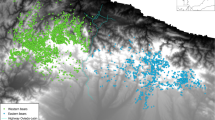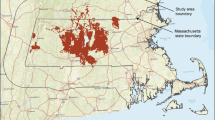Abstract
Besides providing habitat to the grizzly bear (Ursus arctos) and other wildlife, the Rocky Mountain foothills of Alberta, Canada hosts considerable mining, seismic oil and gas exploration and production, and forest harvesting activities. Worldwide, such human activities influence the configuration and composition of the landscape. We assessed seismic cutline effects on landscape structure and grizzly bear use during early summer of 1999 and 2000. We studied five female and two male bears, which were GPS-collared in the spring following den emergence. The area available to this population was stratified into 49 km2 hexagon-shaped sub-landscapes. The scale of this stratification was determined by patterns of bear movement. Fourteen compositional and configurational landscape metrics were calculated within each landscape unit, and bear use points were pooled or ‘binned’ within each unit. Landscape use was related to landscape metrics using a Generalized Linear Model (GLM). We found that seismic cutline proportion did not explain landscape use by grizzly bears; however secondary effects of cutlines on landscape structure did. Declining use was mainly associated with increasing proportions of closed forest, and increasing variation of inter-patch distances, while use was mainly increasing with increasing mean patch size. An earlier investigation had demonstrated that adding seismic cutlines to grizzly bear habitat caused increases in the variation of inter-patch distances. Since the landscape structure of this grizzly bear population will continue to change as a function of increased levels of resource extraction activities in the near future, it is crucial to further study the detailed meaning of landscape structure at the large and small scale for effective conservation efforts.
Similar content being viewed by others
References
G.E.P. Box G.M. Jenkins (1970) Time Series Analysis: Forecasting and Control Holden-Day London, United Kingdom
M.S. Boyce L.L. McDonald (1999) ArticleTitleRelating populations to habitats using resource selection functions Trends Ecol. Evol. 14 268–272 Occurrence Handle10.1016/S0169-5347(99)01593-1 Occurrence Handle10370262
K.P. Burnham D.R. Anderson (2002) Model Selection and Inference: A Practical Information-Theoretic Approach EditionNumber2 Springer-Verlag New York, New York, USA
T.G. Chapin D.J. Harrison D.D. Katnik (1998) ArticleTitleInfluence of landscape pattern on habitat use by American Marten in and industrial forest Conserv. Biol. 12 IssueID6 1327–1337 Occurrence Handle10.1046/j.1523-1739.1998.96227.x
C. Davidson (1998) ArticleTitleIssues in measuring landscape fragmentation Wildlife Soc. Bull. 26 IssueID1 32–37
N.M. Diaz (1996) ArticleTitleLandscape metrics. A new tool for forest ecologists J. Forest. 94 IssueID12 12–16
I.S. Evans (1972) General geomorphometry, derivatives of elevation, and descriptive statistics R.J. Chorley (Eds) Spatial Analysis in Geomorphology Methuen London 17–90
R.T.T. Forman (1997) Land Mosaics, The Ecology of Landscapes and Regions Cambridge University Press CambridgeUnited Kingdom
M-J. Fortin (1999) Spatial statistics in landscape ecology J.M. Klopatek R.H. Gardner (Eds) Landscape Ecological Analysis, Issues and Applications Springer Verlag New York
L. Frair Jacqueline S.E. Nielsen E.H. Merrill S.R. Lele M.S. Boyce R.H.M. Munro G.B. Stenhouse H.L. Beyer (2004) ArticleTitleRemoving GPS-collar bias in habitat selection studies J. Appl. Ecol. 41 201–212 Occurrence Handle10.1111/j.0021-8901.2004.00902.x
S.E. Franklin G.B. Stenhouse M.J. Hansen C.C. Popplewell J.A. Dechka D.R. Peddle (2001) ArticleTitleAn integrated decision tree approach (IDTA) to mapping landcover using satellite remote sensing in support of grizzly bear habitat analysis in the Alberta Yellowhead Ecosystem Can. J. Remote Sensing 27 579–591
R.C. Frohn (1998) Remote Sensing for Landscape Ecology. New Metric Indicators for Monitoring. Modeling, and assessment of Ecosystems Lewis Publishers New York
M.L. Gibeau (2000) A Conservation Biology Approach to Management of Grizzly Bears in Banff National Park, Alberta University of Calgary Calgary, ABCanada 129
Gottschalk T., Huettmann F. and Ehlers M. 2005. Thirty years of analyzing and modelling avian habitat relationships using satellite imagery data: a review. Int. J. Remote Sensing (in press).
D. Hamer S. Herrero (Eds) (1983) Ecological Studies of the Grizzly Bear in Banff National Park. Parks Canada Contract WR 4–80 University of Calgary Calgary, Alberta
D. Hamer S. Herrero (1987) ArticleTitleGrizzly bear food and habitat in the front ranges of Banff National Park, Alberta Int. Conf. Bear Res. Manage. 7 199–213
F. Harrel (2001) Regression Modeling Strategies Springer Verlag New York
S. Herrero (1985) Bear Attacks. Their Causes and Avoidance Hurtig Publishers Edmonton
P.N. Hooge B. Eichenlaub (1997) Animal Movement Extension to Arcview. Ver. 1.1. U.S. Geological Survey AnchorageAK, USA
F. Huettmann A.W. Diamond (2000) Scale questions in seabird research: selected issues for the Northwest Atlantic. Chapter 6 in F. Huettmann. 2000. Environmental Determination of Seabird Distribution in the Northwest Atlantic University of New Brunswick Fredericton, New Brunswick, Canada 480
F. Huettmann J. Linke (2003) ArticleTitleAn automated method to derive habitat preferences of wildlife in GIS and telemetry studies: a flexible software tool and examples of its application Eur. J. Wildlife Res. 49 219–232
D.H. Johnson (1980) ArticleTitleThe comparison of usage and availability measurements for evaluating resource preference Ecology 61 65–71
M.G. Knutson J.R. Sauer D.A. Olsen M.J. Mossman L.M. Hemesath M.J. Lannoo (1999) ArticleTitleEffects of landscape composition and wetland fragmentation on frog and toad abundance and species richness in Iowa and Wisconsin, USA Conserv. Biol. 13 1437–1446 Occurrence Handle10.1046/j.1523-1739.1999.98445.x
R. Laurin D. Thompson (1992) Fundamentals of Spatial Information Systems Academic Press Inc San DiegoCalifornia
S.A. Levin (1992) ArticleTitleThe problem of patterns and scale in ecology Ecology 73 IssueID6 1943–1967
N. Levine (1999) CrimeStat: A Spatial Statistics Program for the Analysis of Crime Incident Locations Ned Levinee & Associates Annandale Virginia
J. Linke (2002) Grizzly bear foothills habitat fragmentation by seismic cutlines mapped from Indian Remote Sensing (IRS) imagery G. Stenhouse R.H.M. Munro (Eds) Foothills Model Forest Grizzly Bear Research Program Hinton AlbertaCanada 82–89
J. Linke (2003) Using Landsat TM and IRS imagery to Detect Seismic Cutlines: Assessing their Effects on Landscape Structure and on Grizzly Bear (Ursus arctos) Landscape Use in Alberta University of Calgary Calgary, ABCanada 149
J. Linke S.E. Franklin (2003) Grizzly bear foothills habitat fragmentation by seismic cutlines: Preliminary report about parsimony of landscape metrics and cutline effects on habitat structure and foothills grizzly bear landscape use G.B. Stenhouse R.H. Munro K. Graham (Eds) Foothills Model Forest Grizzly Bear Research Program Hinton Alberta 68–87
R.D. Mace J.S. Waller T.L. Manley K. Ake W.T. Wittinger (1999) ArticleTitleLandscape evaluation of grizzly bear habitat in western Montana Conserv. Biol. 13 367–377 Occurrence Handle10.1046/j.1523-1739.1999.013002367.x
R.D. Mace J.S. Waller T.L. Manley L.J. Lyon H. Zuuring (1996) ArticleTitleRelationship among grizzly bears, roads and habitat in the Swan Mountains, Montana J. Appl. Ecol. 33 1395–1404
B.F.J. Manly L.L. McDonald D.L. Thomas (1993) Resource Selection by Animals: Statistical Design and Analysis for Field Studies Chapman and Hall London, United Kingdom
Mathsoft. 1999. S-PLUS 2000, Professional Release 2. SeattleWashington.
D.J. Mattson R.R. Knight B.M. Blanchard (1987) ArticleTitleThe effects of development and primary roads on grizzly bear habitat use in Yellowstone National Park, Wyoming Int. Conf. Bear Res. Manage. 7 259–273
P. McCullagh J.A. Nelder (1989) Generalized linear models EditionNumber2 Chapman & Hall London
K. McGarigal S.A. Cushman M.C. Neel E. Ene (2002) FRAGSTATS: Spatial Pattern Analysis Program for Categorical Maps Computer software program produced by the authors at the University of Massachusetts Amherst
K. McGarigal B.J. Marks (1995) FRAGSTATS. Spatial Pattern Analysis Program for Quantifying Landscape Structure U.S. Department of AgricultureForest Service Pacific Northwest Research Station 122
K. McGarigal W.H. Romme M. Crist E. Roworth (2001) ArticleTitleCumulative effects of roads and logging on landscape structure in the San Juan Mountains, Colorado (USA) Landscape Ecol. 16 327–349 Occurrence Handle10.1023/A:1011185409347
B.N. McLellan F.W. Hovey (2001) ArticleTitleHabitats selected by grizzly bears in a multiple use landscape J. Wildlife Manage. 65 IssueID1 92–99
B.N. and Shackleton D.M. McLellan (1989) ArticleTitleGrizzly bears and resource extracting industries: habitat displacement in response to seismic exploration, timber harvesting and road maintenance J. Appl. Ecol. 26 371–380
B.N. McLellan D.M. Shackleton (1988) ArticleTitleGrizzly bears and resource-extracting industries: effects of roads on behaviourhabitat use and demography J. Appl. Ecol. 25 451–460
S. Menard (2001) Applied Logistic Regression Analysis Thousand Oaks California Sage USA
R.H.M. Munroe G.B. Stenhouse (2003) The diet of grizzly bears in West-Central Alberta G.B. Stenhouse R.H. Munro K. Graham (Eds) Foothills Model Forest Grizzly Bear Research Program Hinton Alberta 19–23
J.A. Nagy A.W.L. Hawley M.W. Barrett J.W. Nolan (1989) Population Characteristics of Grizzly and Black Bears in West-Central Alberta Alberta Environment Centre VegrevilleAlbertaCanada
S.E. Nielsen M.S. Boyce (2002) Resource selection functions and population viability analyses G.B. Stenhouse R.H. Munro (Eds) Foothills Model Forest Grizzly Bear Research Program Hinton Alberta 17–42
S.E. Nielsen M.S. Boyce G.B. Stenhouse R.H.M. Munro (2002a) ArticleTitleModeling grizzly bear habitats in the Yellowhead Ecosystem of Alberta: taking autocorrelation seriously Ursus 13 153–164
S.E. Nielsen M.S. Boyce G.B. Stenhouse R.H.M. Munro (2002b) ArticleTitleDevelopment and testing of phenologically-driven grizzly bear habitat models Ecoscience 10 IssueID1 1–10
C. Popplewell (2001) Habitat structure and fragmentation of grizzly bear management units and home ranges in the Alberta Yellowhead Ecosystem University of Calgary Calgary, Alberta
C. Popplewell S.E. Franklin G.B. Stenhouse M. Hall-Beyer (2003) ArticleTitleUsing landscape structure to classify grizzly bear density in Alberta Yellowhead Ecosystem bear management units Ursus 14 27–34
F. Potvin K. Lowell M-J. Fortin L. Belanger (2001) ArticleTitleHow to test habitat selection at the home range scale: a resampling random windows technique Ecoscience 8 399–406
G.P. Quinn M.J. Keough (2002) Experimental Design and Data Analysis for Biologists Cambridge University Press CambridgeUnited Kingdom
R.A. Reed J. Johnson-Barnard W.L. Baker (1996) ArticleTitleContribution of roads to forest fragmentation in the Rocky Mountains Conserv. Biol. 10 1098–1106 Occurrence Handle10.1046/j.1523-1739.1996.10041098.x
B.D. Ripley (1976) ArticleTitleThe second-order analysis of stationarity processes J. Appl. Problems 13 255–266
R.D. Schneider J.B. Stelfox S. Boutin S. Wasel (2003) ArticleTitleManaging the cumulative impacts of land uses in the Western Canadian Sedimentary Basin: a modelling approach Conserv. Ecol. 7 IssueID1 8
C. Servheen (1983) ArticleTitleGrizzly bear food habits, movement and habitat selection in the Mission Mountains, Montana J. Wildlife Manage. 47 1026–1035
Stenhouse G., Boulanger J., Lee J., Graham K., Duval J. and Cranston J. 2005. Grizzly bear associations along the eastern slopes of Alberta. Ursus (in press).
G. Stenhouse R. Munro (2000) Foothills Model Forest Grizzly Bear research Program 2000 Annual Workplan (Year 2) Foothills Model ForestHinton Alberta
A.K. Stuart-Smith C.J.A. Bradshaw S. Boutin D.M. Hebert A.B. Rippin (1997) ArticleTitleWoodland Caribou relative to landscape patterns in Northwest Alberta J. Wildlife Manage. 6 623–633
P. Turchin (1998) Quantitative Analysis of Movement: Measuring and Modeling Population Redistribution in Animals and Plants Sinauer Associates, Inc. Publishers SunderlandMassachusetts
W.N. Venables B.D. Ripley (2002) Modern Applied Statistics with S-Plus EditionNumber4 Springer Verlag New York
J.S. Waller R.D. Mace (1997) ArticleTitleGrizzly bear habitat selection in the Swan Mountains, Montana J. Wildlife Manage. 61 1032–1039
G.C. White R.A. Garrott (1990) Analysis of Wildlife Radio Tracking Data Academic Press Inc. San Diego California
J.A. Wiens (1989) ArticleTitleSpatial scaling in ecology Funct. Ecol. 3 385–397
Author information
Authors and Affiliations
Corresponding author
Rights and permissions
About this article
Cite this article
Linke, J., Franklin, S.E., Huettmann, F. et al. Seismic Cutlines, Changing Landscape Metrics and Grizzly Bear Landscape use in Alberta. Landscape Ecol 20, 811–826 (2005). https://doi.org/10.1007/s10980-005-0066-4
Received:
Accepted:
Issue Date:
DOI: https://doi.org/10.1007/s10980-005-0066-4




